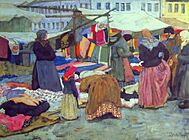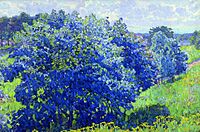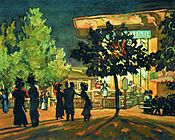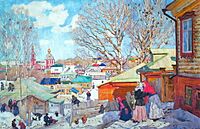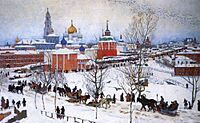Konstantin Yuon facts for kids
Quick facts for kids
Konstantin Yuon
|
|
|---|---|
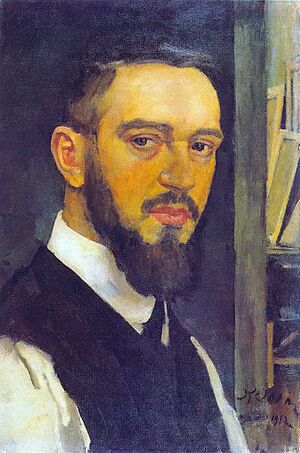
Self-portrait, 1912
|
|
| Born | 24 October [O.S. 12 October] 1875 Moscow, Russian Empire
|
| Died | 11 April 1958 Moscow, USSR
|
| Education | Moscow School of Painting, Sculpture and Architecture |
| Known for | Painting |
| Movement | Impressionism, Symbolism, Socialist realism |
| Spouse(s) | Klavdiya Alekseyevna Yuon (Nikitina) (1883-1965) |
Konstantin Fyodorovich Yuon (born October 24, 1875 – died April 11, 1958) was a famous Russian painter. He also designed amazing sets for plays and operas. Yuon was part of an art group called Mir Iskusstva (World of Art). He also helped start other important art groups in Russia.
Contents
Life and Art Training
Konstantin Yuon was born in Moscow, Russia. His father worked in a bank. Konstantin also had a brother, Paul Juon, who became a well-known composer (someone who writes music).
From 1892 to 1898, Konstantin studied art in Moscow. He went to the Moscow School of Painting, Sculpture and Architecture. His teachers included famous artists like Konstantin Savitsky and Konstantin Korovin. After finishing school, he took more private lessons. He learned from another great artist, Valentin Serov, from 1898 to 1900.
Konstantin Yuon traveled to Western Europe several times. He visited cities like Paris. There, he saw the city paintings of Camille Pissarro and other artists. These artists were part of a style called Impressionism. Even though he saw their work, Yuon kept his own special way of painting.
Teaching and Theatre Work
In 1900, Konstantin Yuon opened his own art school. It was the first private painting and drawing school in Moscow. Many talented Russian painters learned art there. One of them was Olga Zhekulina. Later in his life, Yuon also taught at other big art schools. He taught at the Leningrad Academy of Arts and the Surikov Art Institute in Moscow.
Yuon's art studio in Moscow was a popular place. Other painters often used it for their work. Besides painting, Yuon was also a talented theatre designer. He created the backgrounds and props for plays. He worked for the Moscow Art Theatre and the Maly Theater. From 1945 to 1947, he was the main designer for the Maly Theater. He also designed sets for operas.
Later Life and Awards
During the Soviet era, Konstantin Yuon held important positions in the art world. He was the director of the Research Institute of the Academy of Arts from 1948 to 1950. He also served as the First Secretary of the Union of Soviet Artists from 1956 to 1958.
Yuon received many awards for his art. He won a Stalin Prize in 1943. He also received the Order of Lenin, which was a very high honor. Konstantin Yuon passed away in Moscow on April 11, 1958.
Famous Artworks
Konstantin Yuon started his career painting landscapes and everyday scenes. He used a style called Impressionism. This style focuses on capturing light and color. Some of his early Impressionist landscapes include To the Trinity (1903) and Tverskoy Boulevard (1909).
Later, his art sometimes included ideas from Symbolism. This style uses symbols to show deeper meanings. He also mixed in ideas from old Russian art, like Palekh miniatures and Icons. One of his most symbolic works is a series of prints called Creation of the World. These prints were inspired by the Bible story of creation.
Another famous symbolic painting is New Planet (1921). This painting shows the October Revolution (a big event in Russian history) as if it were a huge change in the cosmos. Towards the end of his life, Yuon painted in a style called socialist realism. This style showed realistic scenes that supported Soviet ideas. A well-known painting from this time is Parade on the Red Square on November 7, 1941.
-
Parade on the Red Square on November 7, 1941, painted in 1949
See also
- List of Russian artists


